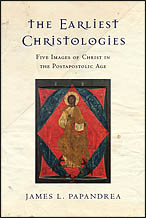"The Earliest Christologies" by James L. Papandrea. A Review.
The Earliest Christologies: Five Images of
Christ in the Postapostolic Age
James L. Papandrea
IVP Academic (InterVarsity Press)
PO Box 1400
Downers Grove, IL 60515
ISBN: 978-0-8308-5127-0; $18.00; May 2016
Reviewed by Rev. Dr. Michael Philliber for
Deus Misereatur
Happily in
the Middle; 5 Stars out of 5
If Richard Weaver
was correct in positing that ideas have consequences, then in the same vein
Christologies have corollaries and repercussions. James L. Papandrea, author, speaker, musician
and associate professor of church history at Garrett-Evangelical Seminary at
Northwestern University, champions exactly this premise in his soon-to-be published
144 page paperback, “The Earliest
Christologies: Five Images of Christ in the Postapostolic Age”. In this short,
readable work Papandrea sets four aspiring Christologies, from the late first and
second Centuries, beside the Christology of the mainstream or majority Church from
the same period. Though at first glance this book may appear to be accessible
only by professionals, the author has done an excellent job in carefully communicating
his subject so that nontechnical readers will be able to easily comprehend the
material.
“The Earliest
Christologies” lays out two forms of Adoptionism, and two forms of Gnosticism that
were raising their heads in the second Century. The author presupposes that the
exponents of these Christologies “were probably sincere believers who thought
souls would be at stake if their opponents won the day” and that each position
grew rather organically “within the
church in the subapostoloic age” (14). Further, Papandrea points out that
from the very beginning of Christianity, Jesus was worshipped and “considered
divine” (15). What separated the Christologies is that they began with “different
assumptions about what divinity is” (16). Generally speaking, the two adoptionist
positions came from a Jewish understanding of divinity, and the two gnostic programs
came from a pagan understanding of divinity (109). The author, after looking at
original source material, shows how each particular Christology worked out in
lifestyle as well as becoming the primogenitors of later Christological and theological
mutations.
Throughout each section
of “The Earliest Christologies,” and in the final chapter, Papandrea outlines
what was the mainstream Christology; the understanding of who Christ was that
was held by the majority of Bishops, priests and theologians (18). He also
follows this prevailing position out to its lifestyle qualities, as well as to
the further theological and Christological clarifications. Of the many
important points that the author makes with regard to the mainstream
Christology, two are worth mentioning. The first is that orthodox Christianity held
neither to a high Christology (Gnosticism) or a low Christology (Adoptionism),
but maintained a beautiful balance (101). Second, Jesus Christ was never
separated into the Jesus of history and the Christ of faith, something that
both the Gnostics and Adoptionists did in their own, peculiar ways. This second
theme is rightly and rhythmically drummed through every chapter.
Although never
mentioned, it is clear that the author is countering recent writers who have
pictured orthodox Christology as just one of many options, all on equal
footing, with orthodoxy winning the day by an excessive use of power, exploitation
and intimidation. Though I went in a different direction, I also addressed many
of these critics a few years back in my own book, “Gnostic Trends in the Local
Church” (see here). Papandrea’s calm and composed approach is masterfully done and will
not leave the reader feeling as if they’ve been in a wrestling match, all tired
and sweaty.
“The Earliest
Christologies” is a simple, well-researched, easily readable resource that
shows how earlier Christianity answered Jesus’ question, “But who do you say
that I am” (Matthew 16.15)? This is a work that lands in the right places, and
would be ideal for anyone looking to knowledgeably respond to Jesus’ query for themselves.
It is just right for High School Christian education lessons, undergrad classes,
and introductory theology courses in seminary. Bible teachers, pastors,
Catechists, Professors, and disciples of Christ at most any age would benefit
from the book. I happily urge you to obtain
a copy soon.
Thanks to IVP
Academic for providing, upon my request, the free copy of “The Earliest
Theologies” used for this review. The assessments are mine given without
restrictions or requirements (as per Federal Trade Commission’s 16 CFR, Part
255).




Comments